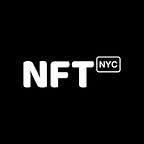By Joy Loftus
The NFT.NYC Clubhouse returned this Wednesday for an hour-long conversation with five decentralized finance (DeFi) thought leaders.
Read on to find out more about:
- How DeFi is implementing NFTs
- DeFi powered NFTs
- NFTs connect artists and bankers
How DeFi is implementing NFTs
We asked one of our featured speakers, Alex Mashinsky, a seasoned entrepreneur and CEO of Celsius Network, to explain the difference between traditional finance and DeFi in layman’s terms:
“Centralized finance involves having an intermediary — a bank or financial institution — that you trust and that is supposed to act in your best interest but really always acts in its own best interest…
Decentralized finance is using blockchain and smart contracts infrastructure, that does not require any intermediaries, to effectively act in your best interest or transact on your behalf.”
Alex then explained how his company Celsius is starting to use NFTs:
“We’re finally getting to the point where you can borrow against NFTs, transact on them, or use them as collateral. Also, there is now enough of a market for NFTs where they can be used to issue loans.”
DeFi powered NFTs
Sami Tannir, a blockchain business analyst at Conflux Network, demystified DeFi in saying that:
“Even with the current NFT platforms that are out there, there is already a sense of DeFi attached to them. DeFi can be anything you want it to be as long as it’s decentralized and has something to do with money and finance.”
Jodee Rich, founder of NFT.Kred and co-founder of NFT.NYC, asked Sami to highlight his favorite DeFi and NFT project.
Sami said that his current favorite is Aavegotchi.
So what is Aavegotchi? Sami parsed it for us:
“Aavegotchi is a game that lives on the Matic Network. On it, you mint portals using the ghost token, and in exchange you are given 1 out of 10,000 unique Aavegotchis…
In order to mint these Aavegotchis, you have to attach Spirit to them. Spirit is an aToken from Aave: “aToken’’ is short for an Aave interest-bearing token.”
In the game, the ERC-20 token that is attached to the Aavegotchi continuously accrues yield and is what determines the Aavegotchi’s value; You always have to collateralize the Aavegotchi’s with a token that has some sort of value.
The rarer the Aavegotchi, the more Spirit required.
Ben Lakoff, CEO of Charged Particles, has incorporated his physics background into his approach to the NFT space.
Like the Aavegotchi game, Charged Particles uses aTokens (ERC-20 tokens), albeit with a spin.
Ben described how this works:
“Aave tokens, or aTokens, can be added to one’s NFTs, which enable an NFT to accrue interest over time.”
NFTs Bring Artists and Bankers Together
It is customary to typecast artists as people who aren’t overly interested or eager about financial strategy. Conversely, bankers are often stereotyped as unartistic and prosaic.
Jordan Lyall, co-founder of Nifty’s, a social media platform for NFTs that will be launching this spring, suggested that the primary impetus driving these two disparate groups together is the challenge of establishing value.
Jordan referenced Upshot, a protocol that unites crypto market experts and NFT creators by enabling real-time NFT appraisals.
It is possible that this modern and more transparent approach to art appraisal will boost the integrity of the valuation of NFT art.
Follow This Week’s Clubhouse Featured Speakers:
- Ben Lakoff, @benlakoff
- Jordan Lyall, @JordanLyall
- Alex Mashinsky, @mashinsky
- Jamiel Sheikh, @jamiel.io
- Sami Tannir, @samit99
Next Week’s Clubhouse Topic: NFTs and the Law
Each Wednesday at 4 pm ET in the lead up to the November in-person event, NFT.NYC will host a session on Clubhouse, focused on a topic suggested by the community. Each session will include Featured Speakers from the upcoming NFT.NYC.
One of this week’s Clubhouse guests, Jess Edo @jessedo, was a musician who asked if we could also talk about tax on NFTs. We will be addressing this in next week’s Clubhouse on NFTs and the Law.
June NFT.NYC topics include:
- June 2nd: The Law and NFTs
- June 9th: Brands and NFTs
- June 16th: NFTs in Fintech
- June 23rd: Women in the NFT Community
- June 30th: NFTs — Identity and Social
NFT.NYC Awards Ceremony
Next week NFT.NYC will be announcing its first NFT Awards Ceremony.
We will be giving the community the opportunity to vote on the best NFT projects of the year.
If you’re passionate about NFTs, and have an interesting use case to share with the community, please apply at our website NFT.NYC.
Speaker applications close July 31st, 2021.
Frequently Asked Questions:
How is DeFi used in the NFT industry?
NFTs can be used in a robust number of ways when combined with DeFi technology. For example, DeFi giant AAVE has a DeFi-focused NFT that runs on its protocol called Aavegotchi. These Aavegotchis may be used as collateral within the decentralized finance space. As mentioned in the Clubhouse conversation by Alex Mashinsky (CEO of Celcius), the future will bring more solutions that create loans for NFTs.
What does DeFi mean?
At its most basic level, DeFi stands for decentralized finance. DeFi is a blanketed term for applications, platforms, and communities that are programmatically and philosophically aligned with a shift away from the prevailing structure of modern financial monoliths.
How can DeFi Benefit NFTs?
When used together, the power of DeFi and NFT technology can compound one another’s potential. As the demand for crypto loans continues, matched with the increasing value of NFTs like Top Shots or Cryptokitties, the potential is endless. One company called NFTfi (backed by NFT.NYC pals Dapper Labs) is capitalizing on this trend. Unlike how traditional DeFi protocols such as AAVE use fungible collateral, NFTfi uses NFTs.
